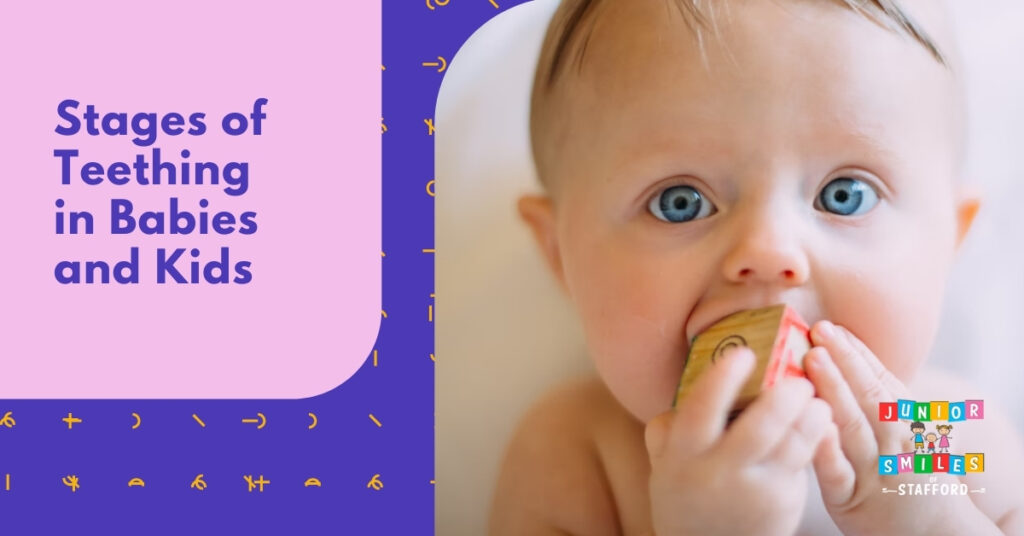5 Stages of Teething for Babies From 0 Month to 3 Years Old

Babies often begin teething around six months of age, but some may experience the emergence of tooth buds as early as 0 months. During this critical period of tooth and enamel development, it’s essential to pay close attention to teething & tooth care to prevent tooth decay, which can affect both baby teeth and eventually adult teeth. When a baby’s first set of teeth erupt, they’re typically the central incisors, located in the middle of the upper or lower jaw.
These stages of teething can be a challenging and uncomfortable process for both parents and babies, as the dull pain can be troublesome and the strange symptoms that come with teething can be disconcerting.
What is Teething?
Teething is a natural process that all infants go through as their first teeth, also known as primary teeth or baby teeth, emerge through their gums. It is characterized by irritability, excessive drooling, the need to put things or hands in the mouth, and sensitive, puffy gums. This developmental phase can start as early as 0 months of age and typically begins with the lower central incisors, the two bottom front teeth. By the age of 3 years, most children will have a full set of 20 primary teeth.
During teething, the tooth buds that were present in a baby’s jawline at birth slowly begin to push through the gum line. It’s a milestone that can be as exciting as it is distressing, given the range of symptoms that can accompany it. These include excessive drooling, a rash around the mouth due to this drool, gum swelling and tenderness, biting behavior, irritability, and a noticeable decrease in appetite for solid foods.
Stages of Teething for Babies
Understanding the process of teething helps caregivers anticipate and recognize the signs of new teeth coming in, allowing for timely interventions to soothe the baby’s gums and address any associated discomfort or symptoms.
First Teeth Eruption (6 Months)
The eruption of the first teeth is an exciting milestone that typically occurs around the six-month mark, with the lower central incisors usually making the first appearance. These tooth buds can cause tender and swollen gums, leading babies to seek relief by gnawing on objects. It’s important for caregivers to monitor this stage closely, as the new teeth’s enamel is still vulnerable and requires gentle care to prevent tooth decay.
The Primary Molars (10-14 Months)
By the time a child reaches 10-14 months, the eruption of primary molars can introduce a new level of discomfort, often marked by increased drooling and a noticeable desire to chew on solid items. These molars play a key role in a child’s ability to chew solid foods properly. Parents may also notice that their baby’s tolerance for pain might be tested during this period, making it important to have a variety of pain remedies on hand, including counter pain relievers recommended by a pediatrician.
Canine Teeth Appearance (16-22 Months)
The appearance of canine teeth, which erupt between the upper and lower incisors, typically occurs from 16 to 22 months of age. The eruption of these teeth can often be uncomfortable, as the pointed canines push through tender gums. Parents should continue using proven pain relief methods from earlier stages and may also introduce cold teething rings or massage the gums with clean fingers to provide relief.
The Emergence of Large Molars (25-33 Months)
The final stage of teething usually involves the emergence of large molars, which can be particularly challenging due to their size and the pressure they exert on a child’s gums. This stage, which occurs between 25 to 33 months, may render previous soothing techniques less effective, prompting parents to try new pain remedies. During this time, it’s also vital to protect the enamel of these new teeth by ensuring the child’s mouth is kept clean and by avoiding sugary snacks that can lead to tooth decay.
Understanding and navigating through these stages of teething can help parents manage their baby’s discomfort and maintain good dental hygiene from an early age. Each stage requires patience and gentle care, but with the right approach, teething doesn’t have to be an ordeal for the baby or parent.
What Are The Common Symptoms of Teething?
Teething is a natural but sometimes difficult process that involves the emergence of a baby’s first set of teeth through the gums. Common symptoms of teething can range from mild discomfort to more challenging issues, affecting both the baby and the parents. Here is an expanded look at each of the typical symptoms:
Drooling
When teething begins, babies might drool more than usual, which can be a sign that the teeth are coming soon. The constant stream of saliva can cause the skin around the mouth, chin, and neck to become wet and irritated, leading to chapping and rashes. To manage this, parents often keep a clean cloth handy to dab away the drool and protect their baby’s skin.
Gum Swelling and Sensitivity
As new teeth push their way through the gums, the area can become red, swollen, and tender to the touch, which is often distressing for the infant. Babies experiencing this symptom might react negatively to feeding or anything else that involves contact with their gums. A cold teething ring or gently massaging the gums with clean fingers can sometimes provide relief to the affected areas.
Chewing Behavior
The pressure from emerging teeth beneath the gums drives babies to seek relief by biting and chewing on anything within reach. This behavior not only helps to alleviate pressure but also can distract from the discomfort. Parents are advised to provide safe, suitable teething toys to satisfy this chewing urge and keep unsafe items out of the baby’s grasp.
Irritability and Fussiness
Teething can make even the most cheerful babies irritable and fussy, particularly in the week that a new tooth is emerging. The constant, dull pain can cause them to cry more often and have difficulty calming down. Regular cuddling, soothing words, and attention can sometimes ease the baby’s distress during these peak periods of discomfort.
Sleep Disturbances
The discomfort associated with teething can interrupt a baby’s sleep patterns, often leading to restlessness at night and shorter naps during the day. These disturbances not only affect the baby but can also lead to sleep deprivation for the parents. Establishing a soothing bedtime routine might help to settle a teething baby and promote better sleep.
Refusing Food
Some teething babies may reject food because the sucking movements required for breastfeeding or bottle-feeding can exacerbate the soreness in their gums. This can be a concern for parents who are trying to ensure their baby is well-fed. Offering cool, soft foods can sometimes encourage eating and provide some pain relief.
Rubbing Face and Ear
Babies may frequently rub their cheeks and tug on their ears during teething due to the pain in their gums that can radiate to other areas of the face or ears. While this behavior is a natural self-soothing technique, it can sometimes be mistaken for ear infections. If there is any doubt, especially if the baby has a fever or persistent discomfort, consulting a pediatrician is advisable.
Slight Temperature Increase
Teething may cause a small rise in a baby’s temperature, but it should not be confused with a high fever. A minor increase in temperature can be normal during teething, but a higher fever is likely a sign of an infection or another ailment. Parents should monitor their baby’s temperature and seek medical advice if the baby exhibits signs of a significant fever or any other concerning symptoms.
What are Effective Ways to Soothe a Child During Teething?
To soothe a teething child, try offering them a clean teething ring or a cold washcloth to chew on, as the pressure can alleviate discomfort. Gently massaging their gums with a clean finger can also provide relief. For older babies, cold foods like yogurt or chilled fruit can be soothing. Ensure toys and teething items are safe and clean. If the baby is particularly distressed, consult with a pediatrician for advice on pain relief methods, which may include specific pain relief gels or medications suitable for infants.
Contact Junior Smiles of Stafford for Teething Support
Navigating through the teething process can be a challenging but crucial part of your child’s early development. As parents, understanding the signs and stages of teething is key to providing the best care and comfort for your little one. It’s important to remember that each child’s experience with teething is unique, and being prepared for a range of symptoms and behaviors is essential.
If you find yourself needing advice or support during this time, don’t hesitate to reach out to Junior Smiles of Stafford. Our team of experienced pediatric dental professionals is dedicated to assisting you in ensuring your baby’s dental health is on the right track from their first tooth. For more information or to schedule a consultation, contact us. We’re here to help guide you and your child through every milestone with care and expertise.

